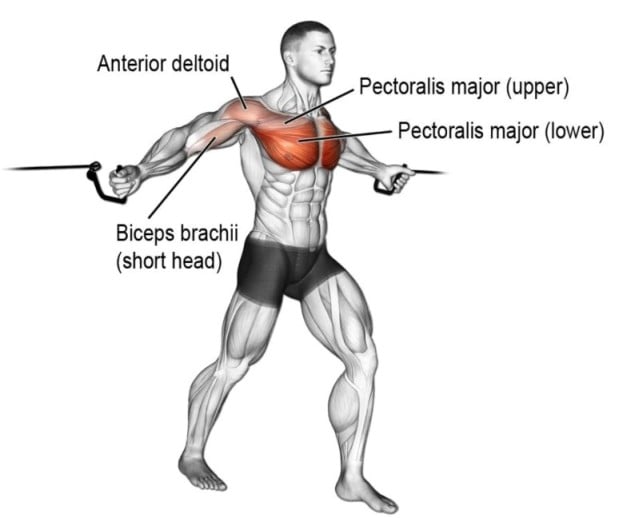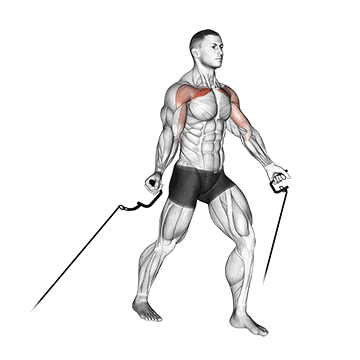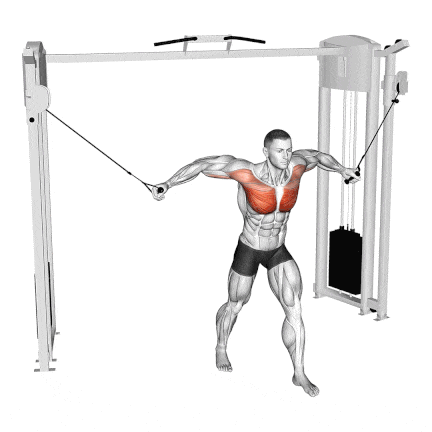Relying solely on the bench press may not be enough to achieve a well-developed chest. Compound lifts are good for building muscles, but you can also do isolate (single-joint) movements like cable crossover that work specific muscle groups to strengthen your muscles.
Bodybuilders have long been using the cable crossover exercise. This technique allows them to exert significant tension on their pectoral muscles without involving other muscle groups.
They offer several advantages over traditional chest exercises like the bench press.
- This exercise allows for constant tension on the chest muscles, which maximizes muscle activation and promotes optimal muscle growth.
- It is a great alternative for people who experience discomfort in their joints during the bench press.
- Provide a wider range of motion and a smooth, controlled motion than traditional free-weight exercises.
Furthermore, the cable crossover allows you to adjust the height and angle of the cables to target different areas of the chest.
- Middle Crossover: Specially target the complete chest with a bit more focus on the inner chest
- Low Cable Crossover: Specially target the Upper Chest
- High Cable Crossover: Specially target the Lower Chest

- Cable Crossover Muscles Worked
- How To Do Cable Crossover
- Cable Crossover Form And Techniques
- Variations of Cable Crossover
- 1. Low Cable Crossover (Low To High Cable Crossover)
- 2. High Cable Crossover (High To Low Cable Crossover)
- 3. Single Arm Cable Chest Crossover
- 4. Pronated Cable Fly
- Conclusion
- References
Cable Crossover Muscles Worked
The cable crossover primarily targets the chest muscles (pectoralis major).
In addition to the chest, other muscle groups are involved as stabilizers and synergists during the exercise.
- Anterior deltoid,
- Serratus anterior
- Biceps Brachii,
- Trapezius
- Rhomboids

How To Do Cable Crossover
- Set the cable machine’s handles at a mid-level, usually around shoulder height.
- Stand in the middle of the cable machine with your feet shoulder-width apart, knees slightly bent, and hips leaning forward.
- Hold the handles in each hand and make sure to hold them tightly.
- Bend your elbows and stretch your arms out to the sides.
- Engage your core and maintain a stable posture.
- Drive the hands forward and together in an arcing motion, allowing them to pass with one hand above and one below.
- When bringing the handles together, focus on squeezing your chest muscles and maintaining tension.
- Pause briefly at the point of maximum contraction.
- Return to the starting position slowly and with control.
- Do 8–12 reps and 3–4 sets

Cable Crossover Form And Techniques
- Don’t round your shoulders or hunch forward. Keep your chest up, shoulders back, and maintain good posture throughout the set.
- When the weight gets tough, this move can be turned into a chest press. Resist heavy Weight. Keep your arms slightly bent and move them in a wide arc to isolate your chest.
- Ensure that you are performing a full range of motion during the crossover.
- Keep your elbows bent. You should never fully straighten your arms or lock them out, as this forces the weight you lift onto the elbows and shoulder joints, increasing your chance of injury.
- Don’t let your elbows move too far; they should align with your torso.
- Avoid using momentum or swinging. Slow and deliberate motions engage the chest muscles more effectively.
- Maintain control by descending for 4 seconds, pausing briefly, and contracting in a reverse motion. Hold and repeat.
- Don’t let your ego get the best of you. Select a weight that you can control, that’s not too light or heavy — find what’s right for you.
- Maintain tension in your abs and don’t allow your back to excessively arch.
- Follow optimum Set, Reps, and Frequency range.
| Level | Sets per Workout | Reps per Set | Frequency |
|---|---|---|---|
| Beginner | 2–3 sets | 8–10 reps | 1 times per week |
| Intermediate | 3–4 sets | 8–12 reps | 1–2 times per week |
| Advanced | 4–5 sets | 8–12 reps (slightly heavier weight) | 2–3 times per week (rest day between sessions) |

Variations of Cable Crossover
While the traditional cable crossover exercise is highly effective, incorporating variations can help spice up your workouts and target different muscle groups.
These variations allow you to target different areas of your chest for balanced development specifically.
- To target the upper chest, perform a low cable crossover.
- To target the lower chest, perform a high cable crossover.
- To target the middle and inner chest, perform a middle cable crossover.
You can also try different hand grips, like an underhand or a neutral grip, to train different chest parts.
1. Low Cable Crossover (Low To High Cable Crossover)
The low cable crossover is an effective isolation exercise that specifically targets the upper chest. A cable machine is used with the handles set to a low position and a motion goes from low to high.
Low to high cable crossover allows for a full range of motion in the upper chest muscles. The upward and diagonal motion stretches and contracts the muscle fibers, which promotes muscle growth and flexibility.

How To Do
- Set both pulleys as low as possible and select the desired weight.
- Stand in the middle of the cable machine with your feet shoulder-width apart and lean forward from the hips.
- Grasp the handles with an overhand grip, palms facing down.
- Bend slightly forwards, and extend your arms, feeling a good stretch in your chest muscles.
- Bend your elbows slightly, and pull your hands toward each other in wide arcs in front of you. Pause when your hands touch.
- Slowly lower back to the starting position.
Know More: Upper Chest Cable Exercises For Bigger & Stronger Chest
2. High Cable Crossover (High To Low Cable Crossover)
The high cable crossover is a great exercise to target the lower portion of your chest.
The high to low cable crossover involves starting with the cable handles positioned at a high position, usually above head level, and then performing a downward and inward motion to target the lower chest muscles.

How To Do
- Set the cable machine handles at a high position, above head level.
- Stand in the center of the cable machine with your feet shoulder-width apart and lean forward from the hips.
- Grasp the handles with an overhand grip, palms facing down.
- Position your arms out to the sides, with a slight bend in the elbows.
- Pull your hands (high to low) toward each other in wide arcs in front of you, pausing when your hands touch.
- Slowly lower back to the starting position and repeat for the desired number of repetitions.
Read More: Lower Chest Cable Exercises For Bigger and Stronger Chest
3. Single Arm Cable Chest Crossover
The one-arm fly is a unilateral variation of the fly. It is used by those who would like to focus on the inner and middle chest. It allows you to isolate and strengthen each side independently, promoting balance and symmetry.
During exercise, you need to move the weight farther away from the middle part of the body. This helps you move your body more and make your inner muscles work harder.

How To Do
- Set the cable machine handle at an appropriate height. It should be slightly above shoulder level.
- Sit or stand perpendicular to the cable machine.
- You should grasp the handle with one arm.
- Extend your arm and have a slight bend in your elbow.
- Slowly pull your hand to the midline of your chest while keeping your upper body straight.
- Hold for a second, and return to the starting position to complete one rep.
4. Pronated Cable Fly
The pronated cable fly is exactly what it sounds like – a classic cable fly but with a twist. Instead of a neutral grip, your palms face down throughout the movement.
This tweak shifts the focus away from your biceps, bringing your triceps into play as a supporting muscle group.

How To Do
- Stand in the machine’s center, arms outstretched, palms facing down (knuckles pointing forward).
- Slowly spread your arms out to the sides until they’re parallel to the floor.
- Maintain a slight elbow bend as you bring your hands together.
- Squeeze your chest muscles as if you’re giving that imaginary tree a good hug.
- Resist the pull of the cables as you slowly return to the starting position.
- Don’t let your arms swing back – keep it smooth and controlled.
Conclusion
The cable crossover exercise is an effective tool for building chest strength and muscle definition. Get ready to push your workouts to the next level with the cable crossover.
Use this guide’s tips and tricks to transform your chest.
References
- Soncin R, Pennone J, Guimarães TM, Mezêncio B, Amadio AC, Serrão JC. Influence of exercise order on electromyographic activity during upper body resistance training. J Hum Kinet. 2014 Dec 30;44:203-10. doi: 10.2478/hukin-2014-0127. PMID: 25713681; PMCID: PMC4327372.
- Santana JC, Vera-Garcia FJ, McGill SM. A kinetic and electromyographic comparison of the standing cable press and bench press. J Strength Cond Res. 2007 Nov;21(4):1271-7. doi: 10.1519/R-20476.1. PMID: 18076235.

Manish is a NASM-certified fitness and nutrition coach with over 10 years of experience in weight lifting and fat loss fitness coaching. He specializes in gym-based training and has a lot of knowledge about exercise, lifting technique, biomechanics, and more.
Through “Fit Life Regime,” he generously shares the insights he’s gained over a decade in the field. His goal is to equip others with the knowledge to start their own fitness journey.
